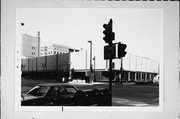Property Record
400 W WISCONSIN AVE
Architecture and History Inventory
| Historic Name: | J. C. Penney's |
|---|---|
| Other Name: | |
| Contributing: | |
| Reference Number: | 113819 |
| Location (Address): | 400 W WISCONSIN AVE |
|---|---|
| County: | Milwaukee |
| City: | Milwaukee |
| Township/Village: | |
| Unincorporated Community: | |
| Town: | |
| Range: | |
| Direction: | |
| Section: | |
| Quarter Section: | |
| Quarter/Quarter Section: |
| Year Built: | 1935 |
|---|---|
| Additions: | 1961 |
| Survey Date: | 1984 |
| Historic Use: | retail building |
| Architectural Style: | Commercial Vernacular |
| Structural System: | |
| Wall Material: | Tile |
| Architect: | Kirchoff & Rose; Grassold & Johnson & Assoc. |
| Other Buildings On Site: | |
| Demolished?: | Yes |
| Demolished Date: |
| National/State Register Listing Name: | Not listed |
|---|---|
| National Register Listing Date: | |
| State Register Listing Date: |
| Additional Information: | Remodelled in 1961. Plankinton Trust was the builder. Lofte & Fredrickson was the engineer. Convention centers have limited life spans and by the 1990s Milwaukee’s Mecca Arena (now U.S. Cellular Arena) needed replacement. To build a newer, larger facility, the City of Milwaukee created the “Wisconsin Center District,” a special development district that assesses local taxes to fund its construction and maintenance. The city awarded a design-build contract to the Cream City Partnership, which paired Clark Construction of Bethesda, Maryland, with Hunzinger Construction Company of Brookfield, Wisconsin. Milwaukee’s European-influenced masonry buildings inspired the design, the creation of D4 Associates, a partnership formed by the architectural firms of Ventulett Stainback and Associates of Atlanta, Georgia, and Engberg Anderson of Milwaukee, and the engineering firms of Graef Anhalt, Schloemer and Associates of Milwaukee and Affiliated Engineers of Madison. The 670,000 square-foot building’s post-modern facade draws on local German-influenced architectural motifs. Artwork incorporated into the building enhances the design. Sidewalk art includes a sculpture garden by Milwaukee’s Sheila Klein, which incorporated fragments from Milwaukee’s streetscapes, such as the lion heads from the AT&T building that had been razed from this site; and Vito Acconci’s, bus shelters and benches, slabs of undulating concrete that appear poised to spring. A circular entrance plaza paved with Carlos Alves’ terrazzo map of Wisconsin greets visitors entering the center. Inside, portals form protruding, hardwood-trimmed arcs, designed by Milwaukee sculptor Jill Sebastian to emulate the hills of southeastern Wisconsin. Sebastian graced these portals and many walls with prose and poetry in bas relief. |
|---|---|
| Bibliographic References: | Buildings of Wisconsin manuscript. |
| Wisconsin Architecture and History Inventory, State Historic Preservation Office, Wisconsin Historical Society, Madison, Wisconsin |

